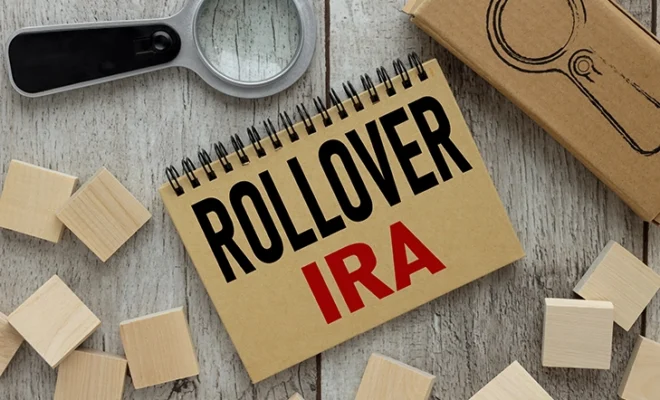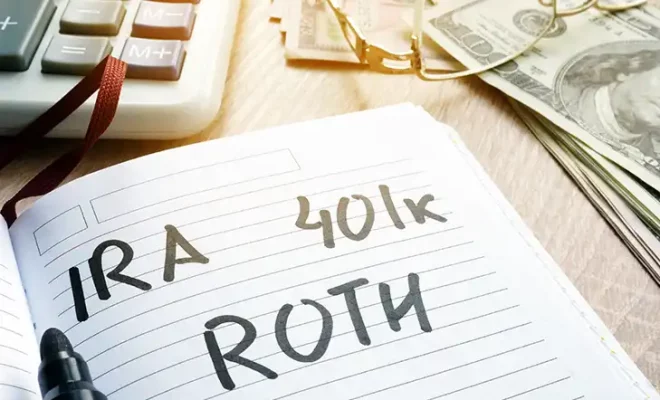How to Minimize Your Tax Liability When Rolling Over to a Roth IRA

Tax considerations play a crucial role in retirement planning, as they can significantly impact your income and savings. Retirees must carefully strategize to minimize taxes during their non-working years. One practical approach is to convert traditional retirement accounts, like a 401(k) or a traditional IRA, into a Roth IRA. However, it is important to consider the immediate tax liabilities that come with converting to a Roth account. The conversion can lead to tax-free withdrawals in retirement, but it involves paying taxes on the converted amount upfront.
A financial advisor can help you understand the best way to convert your 401k to a Roth IRA while minimizing the tax bite. This article will discuss the tax repercussions of Roth IRA rollovers, ways to lower the taxes due, and methods to maximize your retirement income.
Table of Contents
What is a Roth IRA rollover?
A Roth IRA rollover is the process of transferring funds from a traditional retirement account, such as a 401(k) or a traditional IRA, into a Roth IRA.
3 types of Roth IRA conversions you can consider:
1. An indirect rollover
You receive a distribution from your traditional IRA in this method. You have a 60-day window to deposit the distributed amount into your Roth IRA.
2. A trustee-to-trustee rollover
With this approach, you initiate the conversion by requesting your traditional IRA provider to transfer the funds to your Roth IRA provider directly. This method eliminates the time-sensitive aspect of the 60-day window and can be a more secure way to ensure a successful conversion. Since the funds never touch your hands directly, there is no risk of missing the 60-day deadline.
3. Same trustee transfers
If you maintain both your traditional IRA and Roth IRA with the same provider, you can arrange for an internal transfer between the accounts. This is a straightforward process where you instruct your IRA provider to move the funds directly from the traditional IRA to the Roth IRA within the same institution.
A conversion involves moving the money from a pre-tax account, where contributions are typically tax-deductible, into a Roth IRA, where withdrawals in retirement are generally tax-free. Unlike traditional retirement accounts, Roth IRAs do not have mandatory minimum withdrawal requirements during the account holder’s lifetime. This allows retirees more flexibility in managing their distributions and potentially preserving their wealth for a longer period. After the conversion, any qualified withdrawals from the Roth IRA in retirement, including contributions and earnings, are tax-free. This can provide significant tax savings over time.
By paying taxes upfront during the conversion, you may have the opportunity for your investments to grow over time without the burden of future taxation upon withdrawal. Roth IRAs are indeed unique in offering tax-free growth for retirement savings. Earnings within a Roth IRA can grow tax-free, and as long as you follow the rules and wait until you are at least 59.5 years old to make withdrawals, you can access the accumulated income in the account without being subject to income taxes. In addition, you must hold the account for at least five years before making a withdrawal. This distinct feature of Roth IRAs makes them a valuable tool for individuals looking to create a tax-efficient and financially secure retirement.
Tax implications involved in a rollover to a Roth IRA
When considering a conversion from a 401(k) or even a traditional IRA to a Roth IRA, it is essential to understand the tax implications involved. The amount you convert will be subject to income tax in the year of the conversion. The specific tax you owe depends on your income tax bracket and rate, which can range from 10% to 37%. This converted amount is added to your total gross income for that tax year. Let’s break down this concept with an example:
Imagine you find yourself in the 22% tax bracket, and you decide to convert $20,000 from your traditional IRA to a Roth IRA. This $20,000 is added to your income for the tax year. As a result, your overall income, subject to taxation, increases by $20,000.
In this scenario, your tax liability on the conversion would be calculated as follows:
Tax rate: 22%
Converted amount: $20,000
Tax owed: 22% of $20,000 = $4,400
This means that when you convert $20,000 from your traditional IRA to a Roth IRA, and you are in the 22% tax bracket, you would owe $4,400 in taxes on the converted amount. It is crucial to factor in this tax obligation when considering a Roth IRA conversion, as it directly affects the net value of the funds you will have available in your Roth IRA after the conversion is complete.
In addition, when conducting a rollover, it is important to note that you typically have a limited window of 60 days to deposit all the money into a new Roth IRA. This includes the 20% that your company may hold, which will go into the Roth IRA if the rollover is completed within the 60-day period. Failing to meet this deadline could have significant consequences. If you are under the age of 59.5 years, any funds that have not been successfully transferred into the Roth IRA within 60 days may be subject to a 10% early withdrawal penalty in addition to regular income taxes. It is crucial to be mindful of this timeline to ensure that your rollover is executed smoothly and to avoid potential financial penalties.
How to minimize your tax liability while rolling over to a Roth IRA
While there is no way to eliminate tax on a Roth conversion, you can follow some strategies to lower your tax liabilities:
1. Space out your Roth IRA rollover
One effective strategy to reduce your tax liability during a Roth IRA conversion involves spreading the conversion over several years. This approach aims to manage your income within your current tax bracket strategically. Let’s say you are a retiree with an annual income of $60,000, placing you in the 22% tax bracket. The next tax bracket begins at $95,375. By converting just enough from your traditional IRA, you can reach the upper limit of your current bracket. If you are a retiree with an annual income of $60,000 (placing you in the 22% tax bracket and the next tax bracket begins at $95,375), then the correct amount to convert to reach the upper limit of your current bracket would be $35,375.
This way, you can ensure that the additional income from the conversion is taxed at a lower rate. This allows you to optimize your tax savings by avoiding the higher tax rate of the next bracket. This strategy will enable you to effectively control the amount of income you recognize from the conversion each year, minimizing your tax liability and maximizing the benefits of converting to a Roth IRA over time.
2. Capitalize on low-tax years
Retirement often comes with fluctuations in income. During the years between retiring and the commencement of Social Security benefits or RMDs, you might find yourself in a lower tax bracket. You can seize this opportunity to initiate a Roth conversion. Let’s assume you have retired and have an income of $25,000 in a given year. This places you within the 12% tax bracket. By converting $15,000 from your traditional IRA to a Roth IRA, you remain within the same bracket. You effectively capitalize on the lower tax rate while securing tax-free growth for the converted amount.
Not only will this help you minimize your current tax bill due to the lower income, but you will also reduce your future RMDs, which could have pushed you into higher tax brackets. Furthermore, the funds in your Roth IRA will continue to grow tax-free, ensuring tax-efficient wealth accumulation for your retirement years.
3. Anticipate tax law changes
The tax landscape is subject to change due to legislative modifications or political decisions. If you foresee an increase in tax rates due to impending tax law changes, making a Roth conversion before those changes take effect can be a prudent strategy. By converting your traditional IRA to a Roth IRA now, you can lock in your current tax rate, potentially shielding your retirement savings from higher taxes in the future.
For instance, suppose you have a traditional IRA valued at $300,000. You anticipate that tax rates may increase in the next couple of years. By converting a portion of your traditional IRA, say $100,000, into a Roth IRA this year, you pay taxes at your current rate on that amount. If tax rates rise later, you will have effectively reduced the portion of your retirement savings subject to the higher rates.
4. Avoid using money from your Roth IRA to pay your taxes
Paying the taxes owed on a Roth conversion can impact the amount of funds you transfer to your Roth IRA. Experts often recommend paying the tax liability with non-retirement assets rather than using funds from the converted account. By doing so, you ensure that the maximum amount of money remains in your Roth IRA, where it can grow tax-free.
For instance, if your Roth conversion involves a tax liability of $10,000, you can use non-retirement savings to cover the tax bill instead of withholding this amount from your converted funds. Let’s assume the entire amount is $50,000. In this case, a total of $50,000 will enter your Roth IRA. This will provide you with more funds for potential tax-free growth over time.
5. Work with a financial advisor
A qualified financial advisor can provide customized guidance tailored to your unique circumstances. They can analyze your tax and retirement profiles holistically and identify opportunities to optimize your retirement savings while adhering to your investment preferences. If you are unsure about whether a Roth conversion aligns with your current financial situation, a financial advisor can evaluate your income, tax brackets, and retirement goals and recommend the best step forward. They can suggest a partial conversion that keeps you within your current tax bracket and minimize your tax liability while still benefiting from tax-free growth.
To conclude
Optimizing your retirement income through a Roth IRA conversion demands careful consideration and strategic planning. You can make the most of this tax-efficient investment vehicle by spacing out conversions, capitalizing on low-tax years, anticipating potential tax law changes, paying taxes wisely, and seeking professional advice. By taking proactive steps to lower your tax liability during a Roth IRA conversion, you can position yourself for a financially secure and rewarding retirement journey. However, it is important to note that each individual’s financial situation is unique, so consulting a financial advisor is crucial to ensure your strategies align with your specific needs and goals.
WiserAdvisor’s free advisor match service can help you get matched with an advisor who can assist you in effectively planning your Roth IRA rollover, while also suggesting other suitable retirement saving strategies. Answer a few simple questions about your financial requirements, and our matching tool will connect you with 1-3 vetted advisors suited to meet your needs.
For additional information on retirement planning strategies that can be tailored to your specific financial needs and goals, visit Dash Investments or email me directly at dash@dashinvestments.com.
About Dash Investments
Dash Investments is privately owned by Jonathan Dash and is an independent investment advisory firm, managing private client accounts for individuals and families across America. As a Registered Investment Advisor (RIA) firm with the SEC, they are fiduciaries who put clients’ interests ahead of everything else.
Dash Investments offers a full range of investment advisory and financial services, which are tailored to each client’s unique needs providing institutional-caliber money management services that are based upon a solid, proven research approach. Additionally, each client receives comprehensive financial planning to ensure they are moving toward their financial goals.
CEO & Chief Investment Officer Jonathan Dash has been profiled by The Wall Street Journal, Barron’s, and CNBC as a leader in the investment industry with a track record of creating value for his firm’s clients.

















